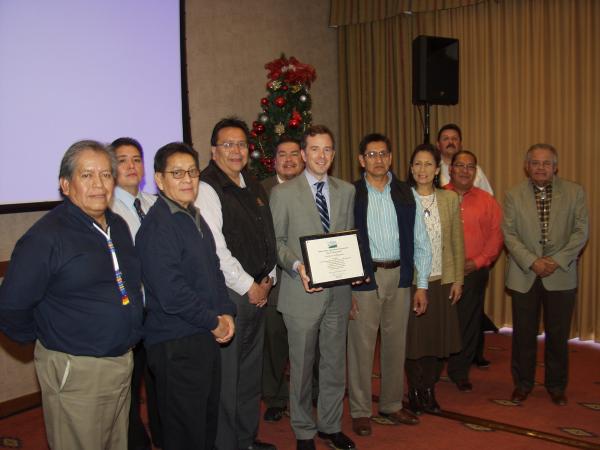Author: Kim Kalliber
American Indian College Fund to Celebrate 25 Years
By Christina Rose, ICTMN
The American Indian College Fund will celebrate its 25th anniversary in 2014. Cheryl Crazy Bull, Sicangu Lakota the president and chief executive officer of the fund, reveals her hopes and goals for the fund’s future. Crazy Bull began her own career teaching at Sinte Gleska University on the Rosebud Reservation, where she worked her way up in the administration to become department chair. Crazy Bull later served as president of Northwestern Indian College in Washington state.
How has the Fund changed in the past 25 years?
The Fund started from nothing 25 years ago, is now giving $5.5 million to $6 million a year, and we have given more than 85,000 scholarships since then.
People think the funds are raised for broadly based education, but it is specifically for the 34 tribal institutions that have educated 20,000 students. The Fund was developed in 1989 by tribal college presidents to support tribal colleges and universities.
The College Fund has been able to grow in a selective environment, and is funded by individuals who are interested in supporting tribal education, and who appreciate the opportunity it brings to the disadvantaged.
What are some of the challenges the Fund has faced?
The Fund is not as broadly known as it should be to really affect those who are seriously disadvantaged. Within the market we do have name recognition; we are probably the largest Native American controlled fund in the country. We offer funding to thousands of colleges, and we support a whole range of programs. In that regard, we are pretty large, but not large enough to provide support to all who apply.
Can all of the applicants receive money through the Fund?
We can support about 25 percent of the applicants, but we estimate that 75 to 90 percent who apply are eligible for financial aid. We know there is a huge gap between what we need and what we can provide. We also know tribal colleges operate on shoestring budgets, and that they can’t compete with other college salaries. But we were able to give some funding to build a number of newer facilities.
The College Fund is in a good position to provide a place for people to invest their money. Anybody who gives money wants to know it will be well spent.
How many of the students who receive funding graduate?
The goal has been towards providing accessibility to funding and not as much effort has been put into tracking, but we are going to start looking at this. We recently did a study and a large percentage of the recipients said that they achieved their educational goals with the support they received. Students express a high level of satisfaction of their experience, and that information comes from an outside agency.
What are some of the goals?
Right now the Fund is positioning for dramatic growth. We are putting a new strategic fund in place, and we want to have a very successful campaign for the 25th anniversary in 2014. We are also preparing to ambitiously work on new marketing programs with Wiedan and Kennedy, an international marketing firm, to capitalize on public interest. I am looking forward to working on that.
What is the best thing a student can do to receive funding?
Go to class and do the work, and ask for the help. To receive funding, students attending a tribal college must meet the criteria of the donor. There are two kinds of funding sources. One goes through the college, and is standard, given according to need and GPA. Then there are funds given by a donor who maybe wants to fund a health major or a certain tribe, and we administer those funds.
In the scholarship arena, the best thing for a student to do is apply. They may be remarkable and talented, but they need to apply. We want to get them to apply even if they don’t get the funding because it helps us show the funders there is a need for more, and who knows, maybe you’ll get one next time.
The Fund originated during the civil rights movement when tribal leaders decided to take education back from the failed policies of the U.S. government. The first tribal college was founded by the Navajo Nation, achieving the goal of teaching their students on the reservation. Today there are 34 tribal colleges and universities in 14 states, serving tribal members from every area of the country.
Read more at http://indiancountrytodaymedianetwork.com/2013/12/16/american-indian-college-fund-celebrate-25-years-152627
The grinch that stole the coal industry’s Christmas
By Todd Woody, Grist

Coal industry executives can only wish Santa will leave them a lump of the black stuff in their stockings this Christmas. But as 2013 draws to a close, those stockings are likely to be empty as the pace of coal-fired power plant closures accelerates.
Market research firm SNL Energy estimates that coal-fired plants generating as much as 64,002 megawatts of electricity will be shuttered by 2021. That’s 5,000 megawatts more than SNL predicted in May. Just since that earlier projection, however, several energy companies and utilities announced they would close some big coal plants, including the Tennessee Valley Authority’s decision in November to take out of service coal-fired power stations generating 3,100 megawatts. That would leave the government-owned utility in the heart of coal country reliant on nuclear and natural gas to generate the bulk of the region’s electricity.
That’s certainly good for the planet, given that coal is responsible for 42 percent of global greenhouse gas emissions.

In the United States, the death of coal is being driven by low natural-gas prices and the imposition of stricter environmental regulations that could make operating a coal-fired power plant a money-losing proposition.
Thanks to the shale gas fracking boom, natural-gas prices remain at rock bottom. That means utilities and power producers are finding it cheaper to switch to that much cleaner-burning fuel than to undertake expensive retrofits of decades-old coal plants to meet new federal emissions regulations. Shale gas now provides nearly a quarter of the U.S.’s natural gas supply and low prices are likely to persist over the next decade, according to SNL.
“Since SNL Energy’s spring analysis, market conditions have shown little improvement, keeping pressure on coal generators,” states the report issued Tuesday. “Natural gas prices remain stubbornly low, which has depressed wholesale electricity prices and spurred competition for coal units from the competing natural gas.”
SNL predicts coal closures could add $5 a megawatt-hour to the wholesale price of electricity in coal-dependent regions of the U.S. Depending on their electricity use, some utility customers would pay $5 more a month on their bill, SNL spokeswoman Christine Twomey told The Atlantic.
In more bad news for the coal industry, on Thursday the U.S. Export-Import Bank approved restrictions on the financing of overseas coal-fired power plant projects. And on Tuesday, the European Bank for Reconstruction and Development in London announced that it would cease financing most coal-fired power plants in Eastern Europe and central Asia. The World Bank and the Obama administration have adopted similar policies.
“We cannot use carbon without having a thought about what the impact of climate change is going to be,” Riccardo Puliti, an executive with the European bank, told Bloomberg. “There is a climate-change problem, and there are actions to be undertaken in order to solve it.”
 This story was produced by The Atlantic as part of the Climate Desk collaboration.
This story was produced by The Atlantic as part of the Climate Desk collaboration.
Free admission to sporting events for senior citizens in Marysville
Go for the Gold!
We often hear the phrase “Go for the Gold” which we know means to go for the best. Here in Marysville many seniors are going for the gold in another way.
In September 2013, Marysville School District superintendent, Dr. Becky Berg, launched the new Marysville Gold Card for eligible senior citizens.
The Marysville School District’s Gold Card holders will have access to all school district-sponsored home athletic and performing arts events at no cost to them, sign up to volunteer in schools, and receive publications from the school district.
The Marysville School District honors and supports the senior citizens of our Marysville and Tulalip communities and supports their social and civic engagement by encouraging them to become involved in our schools and school events. We are offering a special opportunity to invite our communities’ eligible senior citizens to be a part of our Marysville “Gold Card” membership. Thank you to Greg Erickson, Athletic Director, for making this possible for so many.
To make the card more useful, the user’s photo and name will be included on the card as a form of identification for accessing school and district events.
“Our senior citizen neighbors helped build this community and our schools – it’s only right that we give back and honor them in this way,” says Dr. Berg.
Eligible seniors citizens (age 65 and older) can apply for their Gold Card by visiting the Marysville School District office located at 4220 80th Street NE (just two blocks east off of State at the corner of 80th and State Street). Applications may also be completed online at www.msvl.k12.wa.us. Join us today!
For more information, contact the Marysville School District at 360-653-7058.
Creating the First Native American Food Hub in the U.S.

USDA Rural Development State Director Terry Brunner (center) presents a certificate of obligation honoring the successful application of funds to create the first ever Native American food hub in the nation to the Ten Southern Pueblos Council made up by the governors of each Pueblo. The presentation was made to the governors and their representatives during presentation ceremonies at Sandia Pueblo.
Source: Indian Country Today Media Network
Native farmers’ business should receive a nice boost in the near future, thanks to a recent grant and certificate of obligation given to the Acoma Business Enterprise, LLC to develop a business plan for a food hub.
USDA Rural Development State Director Terry Brunner presented the certificate to the Acoma Business Enterprise during the ceremony held at the Southern Pueblos Council monthly meeting.
“The Obama Administration is working hard to create economic opportunities in rural tribal communities,” Brunner said. “This strategic investment will help Native farmers find new markets for their products and offers a path to sustainable farming in the 21st century.”
The $75,000 grant for this project was made available through the Rural Business Enterprise Grant (RBEG) program (RBEG), which promotes development of small and emerging businesses in rural areas. Specifically the RBEG funding will be used to develop a comprehensive business plan and marketing study to create a Native Food Hub, which will be the first of its kind in the nation.
The need to develop a marketing plan came about because the Native American farmers found at the end of the growing season they usually had an abundance of produce that was not being sold or utilized. A food hub will ideally offer a location where native producers can deliver their goods for processing and distribution to market.
The Acoma Business Enterprises was requested by the 10 Southern Pueblo Council to apply for the funding because of the company’s capacity to create the plan and administer the implementation of the marketing of the produce grown in the 10 pueblos.
The RBEG program may also be used to help fund distance learning networks and employment-related adult education programs. Eligible applicants for the program include public bodies, nonprofit corporations and federally recognized Indian Tribes. Since the beginning of the Obama Administration, the RBEG program has helped create or save more than 73,000 rural jobs, provided over copy70.9 million in economic development assistance, improved manufacturing capability, and expanded health care and educational facilities, and has either expanded or helped establish almost 41,070 rural businesses and community projects.
President Obama’s plan for rural America has brought about historic investment and resulted in stronger rural communities. Under the President’s leadership, these investments in housing, community facilities, businesses and infrastructure have empowered rural America to continue leading the way – strengthening America’s economy, small towns and rural communities. USDA’s investments in rural communities support the rural way of life that stands as the backbone of our American values.
Read more at http://indiancountrytodaymedianetwork.com/2013/12/16/creating-first-native-american-food-hub-us-152733
M-PHS Winter Concert Dec. 17
MARYSVILLE — The Marysville-Pilchuck High School Winter Concert will kick off at 7 p.m. on Dec. 17 in the M-PHS auditorium.
This holiday event will feature the school’s award-winning concert choir, symphonic band, wind ensemble and jazz ensembles.
The musical selections are set to include seasonal favorites such as Leroy Anderson’s “Sleigh Ride,” and Leontovych and Wilhousky’s “Carol of the Bells,” as well as classical selections from Johann Sebastian Bach and more contemporary pieces from Harry Belafonte.
As always, musical performances at M-PHS are family events and free to the public.
2013 Christmas Celebration Saturday, December 21st
Christmas Treats All Day! Quil Ceda Creek Casino
Complimentary photos with Santa’s helpers at the main east entrance from 4:00 PM to 10:00 PM!
25 Days of Christmas Cash
$67,000 in Hot Seats
Join the 25 Days of Christmas Cash giveaways every day thru Christmas Eve in December starting at noon. There will be a $250 cash winner every two hours, every day! On Christmas Day there will be ten (10) winners of $2,500 each every two hours.
Players must be present to win. Card activation required between 12:00 PM (noon) and 12:00 AM (midnight) on all drawing dates, except Christmas Day between 6:00 AM and 12:00 AM (midnight). All winners will be drawn by virtual selection through the player tracking database. Must be 21 and over.
As Long As The Rivers Run: An Original Musical Play About Salmon And The Indians Who Love Them
Please join Red Eagle Soaring Native Youth Theatre on Sunday, December 15th for a performance of As Long As The Rivers Run, an original musical play by Roger Fernandes (Lower Elwha Klallam) about the historical and contemporary relationship between salmon and Northwest Native peoples. Reception and refreshments following, all are welcome.
Washburn Names Dr. Charles Roessel Director of the BIE
Source: Indian Country Today Media Network
On December 11, Dr. Charles M. “Monty” Roessel was named Director of the Bureau of Indian Education while touring a BIE tribally controlled grant school located on the Pueblo of Laguna in Laguna, New Mexico.
The announcement came from Assistant Secretary – Indian Affairs Kevin Washburn, who accompanied Roessel and Secretary of the Interior Sally Jewell on the tour.
The Navajo Nation member had been serving as the acting director since February 2012.
The initial tour included a roundtable with principals from other local tribally controlled grant schools and BIE-operated schools and will be used by Interior for it’s “American Indian Education Study Group, a group that is working to improve educational outcomes for American Indian students attending BIE-funded schools,” according to a Department of the Interior release.
“The BIE plays a major role in the education of thousands of American Indian students across Indian country,” Washburn said. “As acting director, Dr. Charles M. Roessel has proven to be an effective steward of our Indian education programs, bringing to the Bureau extensive experience in school leadership and administration, and an understanding of what’s needed at the local school level. He is a strong and effective member of my senior management team.”
Roessel brings a background of educational wealth into the Washington, D.C. based position. In 2007 he started his service as superintendent of Rough Rock Community School, a BIE-funded, tribally operated K-12 boarding school near Chinle, Arizona, on the Navajo Nation reservation. He had been with the school since 1998 where he started as director of community services. In 2000 he became the schools executive director. In 2011 he was named the BIE’s Associate Deputy Director for Navajo Schools. In the position Roessel oversaw 66 BIE-funded schools throughout Arizona, New Mexico and Utah on the Navajo Nation reservation. From 2010 to 2011 he served as chair of the DOI’s No Child Left Behind Negotiated Rule Making Committee and on the Sovereignty in Navajo Education Reauthorization Task Force with the Navajo Education Department of Diné Education according to the release.
“I want to thank Assistant Secretary Washburn for his confidence in me for this important post,” Roessel said. “I am looking forward to working with Assistant Secretary Washburn and his team to ensure that the Bureau of Indian Education continues to fulfill its two-fold mission of providing our students with a quality education while respecting tribal cultures, languages and traditions.”
Roessel will now be reporting directly to Washburn and will head a staff that includes three associate deputy directors who are responsible for education line offices serving 183 BIE-funded elementary and secondary day and boarding schools, along with peripheral dormitories located on 64 reservations in 23 states. Throughout the BIE-funded schools more than 40,000 American Indian and Alaska Native students from federally recognized tribes receive their education.
In addition, the Bureau “serves post-secondary students through higher education scholarships and support funding to 26 tribal colleges and universities and two tribal technical colleges.” The Bureau also runs Haskell Indian University in Lawrence, Kansas and the Southwestern Indian Polytechnic Institute in Albuquerque, New Mexico – two post-secondary institutions.
While Roessel was at Rough Rock Community School, the first American Indian-operated, and the first Navajo-operated school when it opened in 1966, he oversaw a major school replacement and improvement project funded under the American Recovery and Reinvestment Act of 2009. The project was carried out by the Indian Affairs Office of Facilities, Environmental and Cultural Resources with the new facilities opening its doors on August 5, 2011.
Roessel holds a Bachelor of Science degree in Photo-Communication/Industrial Arts from the University of Northern Colorado-Greeley (1984), a Master of Arts degree in Journalism from Prescott (Arizona) College (1995) and a Doctorate of Education degree in Educational Administration and Supervision from Arizona State University in Tempe (2007).
Read more at http://indiancountrytodaymedianetwork.com/2013/12/12/washburn-names-dr-charles-roessel-director-bie-152669









